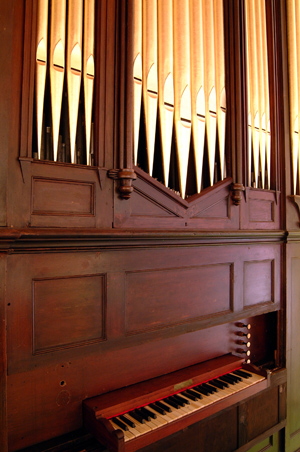 Monday, 22 October, 9.30 p.m.
Monday, 22 October, 9.30 p.m.
Church of São Pedro
Tuesday, 23 October, 8.30, p.m.
Church of Nossa Senhora de Guadalupe,
(Porto da Cruz)
Galina Stetsenko, organ
Denys Stetsenko, baroque violin
Johann Sebastian Bach (1685-1750) is unquestionably the greatest genius of the whole baroque. Born into a family of long musical tradition, he showed his talent early and soon became a complete musician. An untiring student, he acquired a vast knowledge of the European music of his time and of earlier generations. He served in various capacities in German courts and churches, but one of his most important functions was that of Kantor of the Church of St Thomas and Director of Music of the city of Leipzig.
To open this recital, we have chosen one of the six Trio Sonatas written by Bach for solo organ, in which the bass part is played on the pedal board, and the solo voices distributed between the hands of the organist. The version given here compensates for the absence of a pedal board on Iberian organs by adding the violin as the performer of one of the solo voices, the bass part thereby passing to the organist’s left hand.
The Trio Sonata or Sonata in Trio is a musical form normally composed for two solo melody instruments and basso continuo, making up the three parts for which the group is named “Trio Sonata”.
Domenico Scarlatti (1685-1757) was an Italian composer and harpsichordist born in Naples. Coming from a musical family, it is very probable that he received his first music lessons from his father, the composer and teacher Alessandro Scarlatti. Domenico’s talent showed itself early: at the age of only 15, he was hired as organist and composer to the Royal Chapel in Naples. He was then chapelmaster of Maria Casimira, the Queen of Poland exiled in Rome. Following a more lucrative invitation from King John V of Portugal, Scarlatti agreed to move to Lisbon in 1719 in order to be the royal composer and to teach Princess Maria Bárbara and Prince António. Also known in Portugal as Domingo Escarlate, he produced an extensive series of keyboard sonatas, many of them dedicated to the Princess. In this concert the Sonata in B minor, K87, will be performed.
Carl Philipp Emmanuel Bach (1714-1788), a German composer, born in Weimar, was the second son of Johann Sebastian Bach end his first wife, the singer Maria Barbara. After having learnt music with his father, he worked as harpsichordist at the court of Frederick the Great in Berlin and, from 1667 onwards, as chapelmaster in Hamburg. Considered a great virtuoso of the clavichord and the piano, then in its earliest phase of development, he contributed significantly to the development of sonata form for this instrument. His output includes concertos, symphonies, vocal and chamber music, as well as separate pieces for various instruments.
Johann Christoph Frierich Bach (1732-1795) was born in Leipzig, the ninth son of the marriage between J.S.Bacj and the singer Anna Magdalena Wulken. He learnt music with his father, as did all his brothers. In 1750, after leaving the University of Leipzig, where he had been studying law, he became a chamber musician at the court of count Wilhelm von Schaumburg-Lippe, in Buckeburg, becoming in addition concertmaster in 1757. He wrote some twenty symphonies, six keyboard concertos, chamber music, works for solo instruments, an opera (lost) and various cantatas and oratorios on texts adapted by the poet Gottfried Herder, with whom he collaborated between 1771 and 1776.
About the composer Francisco Xavier Baptista (?-1797) nothing is known, except that he was, according to José Mazza’s Diccionario Biographico de Musicos Portuguezes, organist of Lisbon Cathedral. From his pen are known only twelve sonatas for harpsichord and a modinha for two voices with harpsichord accompaniment.
Maksym Berezovsky (1740-1777) was a Ukrainian composer about whose life and work little is known, except that he was a member of the chapel of Prince Piotr Fedorovich in Orianenbaum, near St Petersburg, and that he received lessons from Father Battista Martini at the Philharmonic Academy in Bologna. On his return to St Petersburg, he was appointed a member of the staff of the royal theatres and chapelmaster of the court, remaining in these positions until his death, whose circumstances are still unknown today, some maintaining that he committed suicide, and others that he suffered from a psychiatric illness. His output includes a number of choral works for the Orthodox Church, an opera (Demofonte), a symphony and a sonata for violin, composer in 1772 in Pisa, Italy, and which will be heard today for the first time in Madeira, in a historically informed performance.
Denys Stetsenko
Organ and Violin Recital
Johann Sebastian Bach (1685-1750)
Trio Sonata no. 5 in C major, BWV 529
Allegro
Largo
Allegro
Domenico Scarlatti (1685-1757)
Sonata in B minor, K87 (organ solo)
Andante mosso
Carl Philipp Emanuel Bach (1714-1788)
Sonata à Cembalo obligato e Violino H.502
Adagio ma non molto
Allegro
Adagio
Menuetto I – Menuetto II
Johann Christoph Friedrich Bach (1732-1795)
Allegretto com XVIII variationi «Morgen kommt der Weihnachtsmann»
Allegretto (Thema) - Variation I - Variation II - Variation III - Variation IV minore
- Variation V maiore - Variation VI Tempo di Minuetto - Variation VII Tempo primo
- Variation VIII Schwaebisch - Variation IX minore Allegretto - Variation X maiore –
Variation XI- Variation XII Siciliana, poco Allegro- Variation XIII Allegro –
Variation XIV- Variation XV - Variation XVI - Variation XVII minore - Variation
XVIII maiore
Francisco Xavier Baptista (?-1797)
Sonata in G major for Harpsichord and Violin
Allegro
Allegro – Minore - Allegro
Maksym Berezovsky (c.1740-1777)
Sonata for Violin and Basso Continuo (1772)
Allegro
Grave
Minuetto com 6. variazioni
Participants
|
Studied at the Tchaikovsky State Conservatory in Kyiv, the capital of Ukraine, where she studied between 1975 and 1980 with Galina Bulybenko and Mykola Sul, earning the higher diploma in organ and piano. Between 1980 and 1994 she taught at the Special Professional School for talented young musicians. She has worked as a soloist and with chambre ensembles, including the Stetsenko Trio, in various cities in Ukraine, as well as in Belgium and France. In 1998 she took part in the Iberian Organ Symposium in the Autonomous Region of the Azores. Between 1996 and 1999 she was the accompanist in various masterclasses given by Felix Andrievsky and Zakhar Bron in Spain and Portugal. In 2003 she took part in the International Conference “The Organ and the Liturgy Today” which took place in Fátima. In 2009 she participated in a masterclass given in Lisbon by the organist José Uriol. She has appeared in the Chamber Music Series organized by the Classical Orchestra of Madeira, and since 1995 has taught organ and piano at the Conservatory-Professional School of Arts of Madeira. |
|
Was born in Ukraine, where he grew up in a musical family. He began his violin studies at the age of 6 with his uncle. He has been resident in Portugal since 1995. He studied at the Higher National Orchestral Academy and at the Higher School of Music in Lisbon, where he gained his licentiate in violin. He has been principal violinist of the Metropolitan Academic Orchestra and of the Symphonic Youth Orchestra, and has been a member of the Coimbra Chamber Orchestra. He has taken part in various masterclasses, given by Felix Andrievsky, Zakhar Bron, Gerardo Ribeiro, Richard Gwilt, Chiara Bianchini, Enrico Onofri, Vittorio Ghielmi and others. He is currently taking a masters’ degree in early music and baroque violin at the Higher School of Music and Stage Arts in Oporto, under the supervision of Amandine Beyer. He works with the Portuguese baroque orchestras Divino Sospiro, Capela Real, Os Músicos do Tejo and the early music groups Sete Lágrimas, Concerto Campestre and La Nave Va. He is a founder member of the Arabesco Quartet and participates in traditional music and dance projects. Since 2002 he has taught violin and chamber music at the St Cecilia Academy of Music. He is a professor in the School of Music and Performing Arts of Porto, as assistant to Amandine Beyer. |
Notes about the Organ
|
The organ of the church of São Pedro was obtained in England from the firm Flight & Robson in the 19th century. We have no documentation relating to its construction but we may place it as before 1878, when the firm was bought by Gray & Davison. We know equally little of the exact date of the installation of the instrument in the church, but in two inventories (1838, 1841) there is reference to an organ “of which much use is made” placed in the choir gallery, which point to the present instrument (AHDF Inventário: 3). In the course of the 20th century, the organ underwent various repairs, as a result of which, among other things, the pitch and tuning were altered, without, however, causing any significant damage to the original state of the instrument. In August 1904, in the course of a campaign to make improvements to the choir gallery of the church, the Benefice took advantage of the opportunity to have the organ repaired, the restoration being undertaken by Alfredo Saturnino Lino. We know that the work to the organ, as to all the rest, took a short time, for in a note signed 6 August 1904, the builder stated that the work "should be finished by the middle of the present month" (AHDF Documentos). The works actually finished on 25 August; all told, the work to the choir gallery and organ cost 150,000 réis, to which the District General Council contributed the sum of 50,000 réis, given over entirely to the repairs to the organ. Apparently, this work was a one-off intervention, for only two years later, the newspaper Heraldo da Madeira, on 15 November 1906, reported that the organ of the church of São Pedro was once more under repair. In 2006 a full restoration was undertaken by Dinarte Machado. Manual (GG, AA, C, D-f’’’) Diapason 8’
|
|
This instrument was built in the 19th century by the English firm Flight & Robson of London (op. 101). It is an organ technically identical to that of the Parish Church of São Vicente and is situated in the choir gallery. We were unable to consult documentation about this instrument, and the circumstances and date of its acquisition are unknown. It was restored by Dinarte Machado in 2004-2005. Manual (G, AA, C, D-f’’’) Open Diapason 8’
|
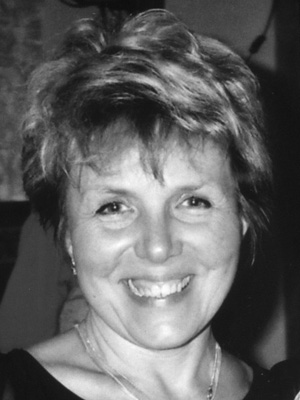 Galina Stetsenko
Galina Stetsenko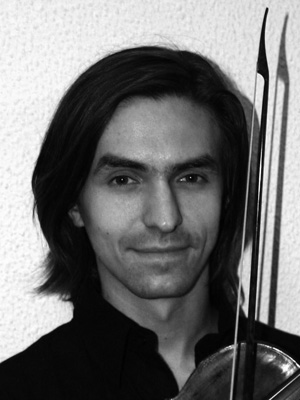 Denys Stetsenko
Denys Stetsenko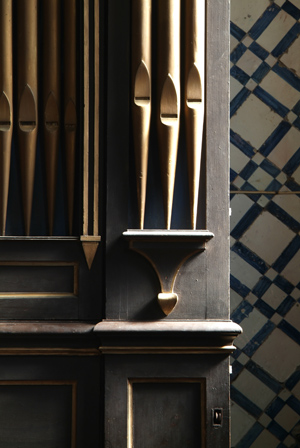 Church of São Pedro
Church of São Pedro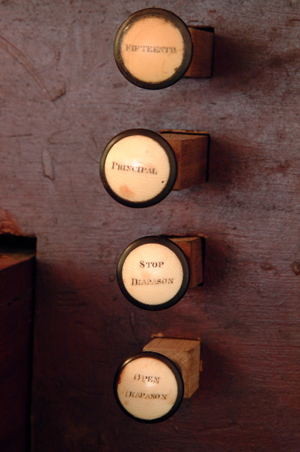 Church of Nossa Senhora da Guadalupe, Porto da Cruz
Church of Nossa Senhora da Guadalupe, Porto da Cruz